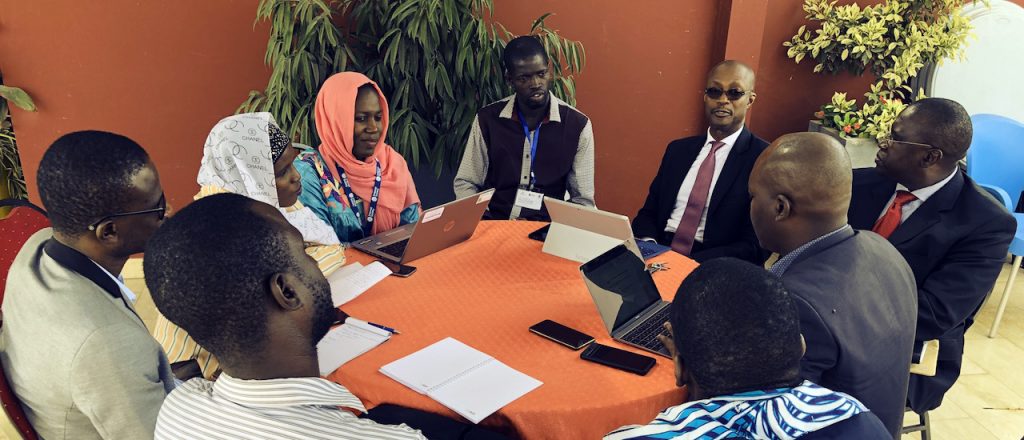Arista Works With Red Hat and Tigera on Container Environments for Enterprises
 The collaboration focuses on the three biggest container pain areas for enterprises: 1) networking; 2) visibility; and 3) security.
The collaboration focuses on the three biggest container pain areas for enterprises: 1) networking; 2) visibility; and 3) security.
 The collaboration focuses on the three biggest container pain areas for enterprises: 1) networking; 2) visibility; and 3) security.
The collaboration focuses on the three biggest container pain areas for enterprises: 1) networking; 2) visibility; and 3) security.

Connecting the most remote and challenging territories of any country to the Internet can be tough. Typically, Internet access spreads gradually from urban conglomerations towards smaller hubs, and finally, to the most remote and sparsely populated areas. This is just common business sense.
Many of these remote areas are unique in terms of their people, culture, and livelihood, and Internet access can make a world of difference. This was the case when the Internet Society, together with its local partners, launched the first community network in Georgia, in the mountainous region of Tusheti, in September 2017.
Creating Impact
One year on, the Internet has made a significant difference to the lives of the Tushetians. This week, the Internet Society published an impact assessment on the Tusheti community network highlighting the transformation in tourism, e-commerce, and people’s livelihoods.
The Internet has had a positive impact on tourism through more effective online advertising and sales, and through efficiencies in businesses operations. With these encouraging developments, local residents are investing in the construction and opening of new guesthouses. The Internet has also increased the levels of safety and mobility in this remote part of the world by providing a communications channel to Continue reading
 Joe Cozzolino departs Cisco to join private equity firm; CenturyLink CTO joins the MEF board of directors.
Joe Cozzolino departs Cisco to join private equity firm; CenturyLink CTO joins the MEF board of directors.
On today's Tech Bytes, sponsored by HPE and Intel, we explore HPE's Composable Fabric. It combines top-of-rack switches and automation software to pool networking resources and help your data center scale. We also discuss how Composable Fabric integrates with Simplivity, HPE's hyperconverged platform.
The post Tech Bytes: HPE’s Composable Fabric For Data Center Automation (Sponsored) appeared first on Packet Pushers.


I’ve done quite a bit of research in the Huawei issue. There are two key areas that I will cover in this review of the available information. The network has to work before it can secured. Software Quality and poor process. Insider Threats by Chinese Nationals. TL:DR Huawei has substantial problems with product quality and […]
The post Are Huawei Products Unsafe or Insecure ? A Review appeared first on EtherealMind.
 More than 61 percent of shareholders approved the deal that allows Dell to buy back the stock that tracks its controlling stake in VMware.
More than 61 percent of shareholders approved the deal that allows Dell to buy back the stock that tracks its controlling stake in VMware.
 The telecom giant is looking to cut $10 billion in costs from its operations as it positions itself to boost its focus on 5G.
The telecom giant is looking to cut $10 billion in costs from its operations as it positions itself to boost its focus on 5G.

This reddit post asked the question: For example, I’m going through a Cisco Live presentation on troubleshooting ASR routers, and the first 50 slides or so are completely dedicated to describing the Route Processors, Packet Engines, ASICs, Buffers, etc., and the different paths that packets can take through the hardware. While that’s all obviously important […]
The post Response: How Important is it to Understand Hardware Architecture? appeared first on EtherealMind.

On April 4, 2018, the Canadian Multistakeholder Process: Enhancing Internet of Things (IoT) Security held its first convening in partnership with the Canadian Internet Registration Authority (CIRA); CANARIE; Innovation, Science and Economic Development (ISED) Canada; and the Canadian Internet Policy and Public Interest Clinic (CIPIC). Over 80 participants from government, academia, public interest, industry, and other organizations attended the first meeting and many have continued to engage at in-person and virtual meetings ever since. Over the past eight months, this group has experienced significant success in the areas of consumer education, labeling, and network resiliency. And these achievements have been well-noted on a global scale.
A delegation from Senegal came to Canada in July to meet with members of the Enhancing IoT Security oversight committee. The group was comprised of government officials, Senegal Chapter members, and staff from the Internet Society’s African Bureau. The delegation met with Canadian government officials, technologists, public interest groups, and North American Bureau staff to learn more about how and why the IoT security project was initiated, and what the group had accomplished to date. The group discussed the significant successes the Canadian multistakeholder group had already achieved, the challenges it faced, Continue reading
This is a liveblog of the KubeCon NA 2018 session titled “Hardening Kubernetes Setup: War Stories from the Trenches of Production.” The speaker is Puja Abbassi (@puja108 on Twitter) from Giant Swarm. It’s a pretty popular session, held in one of the larger ballrooms up on level 6 of the convention center, and nearly every seat was full.
Abbassi starts by talking about Giant Swarm’s environment, in which they run more than 100 clusters across different clouds and different regions. These clusters are running for different companies, different industries, and they serve different use cases for various constituents of users. Abbassi says that Giant Swarm opts to give users more freedom in how they use (and potentially misuse) the clusters.
Obviously, this can lead to problems, and that’s where the postmortems come into play. Abbassi explains the idea behind postmortems by quoting a definition from the Google SRE book, and then provides some context about the process that Giant Swarm follows when conducting postmortems. That leads into a discussion of various postmortems conducted at Giant Swarm.
The first one mentioned by Abbassi concerns a memory leak first fixed in 1.11.4 and 1.12.0. Prior to Continue reading

I’m convinced that Bloomberg is wrong about the hardware implants. Until they retract the story they don’t have credibility to report on technology. Supermicro commissioned 3rd party audit and found nothing which is confirmation of many other sources who also refute the claims. The ONLY people making the claim is Bloomberg and there is no […]
The post Response: Super Micro says no implants on motherboards appeared first on EtherealMind.

Over 100 community members, including head masters, government officials, teachers and heads of primary and secondary schools gathered in Buhera rural district council of Zimbabwe on 15 November, eager to engage in discussions related to the initial deployment of the Murambinda Works Community Network. Schools, health and the local authority facilities have been earmarked as the initial benefactors for the inaugural roll out of the Murambinda Works Community Network.
The CEO of Murambinda, Mama Emilie gave a welcoming speech followed by the district school inspector of Buhera who talked about the importance of equipping their schools with ICT. “We cannot imagine a good curriculum that has not taken into consideration ICT. The partnership with Internet Society is a blessing to the district. We want to support it until infinity,” he said. The inspector also mentioned some of the challenges they are facing in their schools including the lack of power, unavailability of computers and connectivity. (Since 2015, 1200 teachers have been trained in ICT, but couldn’t do much with their acquired knowledge.)
TelONE, the national Telecommunications parastatal company with infrastructure in Murambinda Town, was also present at the workshop. “One man cannot make it but we can work together Continue reading
This is a liveblog of the KubeCon NA 2018 session titled “Linkerd 2.0, Now with Extra Prometheus.” The speakers are Frederic Branczyk from Red Hat and Andrew Seigner with Buoyant.
Seigner kicks off the session with a quick introduction before handing off to Branczyk. Prometheus, for folks who didn’t know, originated at SoundCloud with a couple of ex-Googlers. Prometheus is one of the graduated CNCF projects and—judging by a show of hands in response to a speaker question—lots of folks here at KubeCon know about Prometheus and are using Prometheus in production.
Branczyk provides an overview of Prometheus, explaining that it pulls metrics from a target on a set of regular intervals (like every 15 seconds, for example). Prometheus stores those metrics in a time-series database, so every time it pulls metrics it stores them in a time series. As a monitoring solution, it also has to provide alerting, to notify cluster operators/administrators that some metric is outside of some predefined threshold.
With regards to Kubernetes, Prometheus has built-in support to perform service discovery in Kubernetes by querying the Kubernetes API. This enables it to discover Pods backing a Service and scrape (pull) the metrics from those discovered Continue reading
This is a liveblog from the day 1 (Tuesday, December 11) keynote of KubeCon/CloudNativeCon 2018 in Seattle, WA. This will be my first (and last!) KubeCon as a Heptio employee, and looking forward to the event.
The keynote kicks off at 9:02am with Liz Rice, Technology Evangelist at Aqua Security. Rice welcomes attendees (back) to Seattle, and she shares that this year’s event in Seattle is 8x the size of the same event in Seattle just two years ago. Rice also shares some statistics from other CNCF events around the world, stressing the growth of these events both in size and in the number of events happening worldwide.
Rice next shares some entertaining statistics about web site visits to kubernetes.io versus some other popular brands. (TL;DR: Kubernetes gets more web site visits than the Seahawks and Manchester United, but not as many as Starbucks.)
Moving on, Rice talks for a few minutes about the strategy or purpose behind the collection of projects that fall under the CNCF umbrella (to provide some of the important building blocks in the full stack of technologies to support cloud-native environments). At this point, Rice turns it over to Michelle Noorali, Continue reading
Silicon Valley is both an addiction and passion where entrepreneurs seek the realm of the impossible. Real-time language translation, fraud detection, and autonomous vehicle control are being addressed through the use of neural network models, detecting patterns and behaviors across massive amounts of structured and unstructured data. Indeed, change is not only a constant progression in Silicon Valley, it is a continuum in time. Every piece of traditional technology has to imminently become smarter, challenged or be eliminated. While this transformation is especially true for entrepreneurs, invention is not limited to start-ups. I have witnessed several waves of evolution and revolution during my journey in Silicon Valley in both high-tech and networking.
New applications, an explosion in mobile device use, and IoT are driving Wi-Fi connectivity needs through the roof. 802.11ax tries to address the issues while creating new opportunities and services.